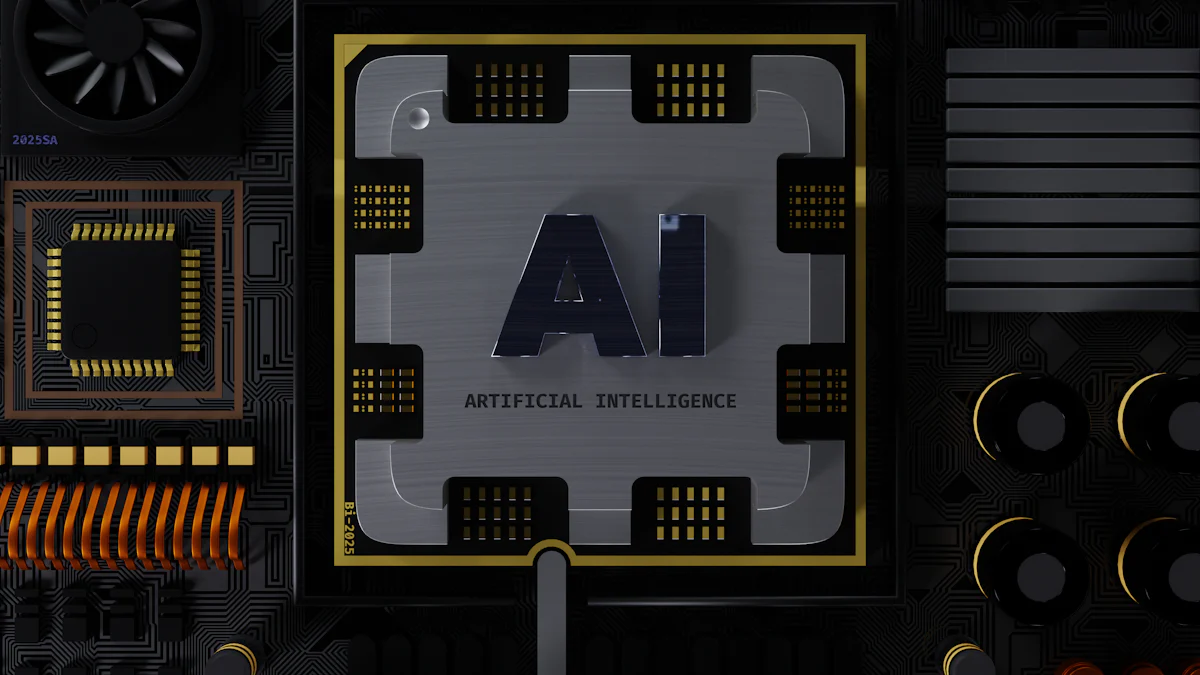Semiconductor Industry Insights - August 2024

The semiconductor industry stands as a cornerstone of modern technology, driving advancements in various sectors. Staying updated with the latest semiconductor news is crucial for understanding market dynamics and technological progress. The industry's rapid growth and innovation demand constant attention to trends and developments. This blog aims to provide valuable insights into the current state of the semiconductor sector, highlighting key trends and significant milestones.
Global Market Overview
Market Trends and Growth
Key Market Drivers
The semiconductor industry continues to experience robust growth, driven by several key factors. The increasing demand for consumer electronics, including smartphones and laptops, fuels this growth. The automotive sector's shift towards electric vehicles (EVs) and autonomous driving technologies also contributes significantly. Additionally, the expansion of 5G networks and the Internet of Things (IoT) accelerates the need for advanced semiconductors.
Emerging markets in Asia-Pacific show remarkable growth potential. The region expects a 14% increase in market size in 2024, driven by the recovery of the global personal device market. New growth opportunities in sectors like healthcare and smart cities further bolster this trend. The Americas and China also report significant sales surges, reflecting strong market dynamics.
Market Challenges
Despite the positive outlook, the semiconductor industry faces several challenges. Geopolitical tensions disrupt supply chains and create uncertainty. Trade policies and regulations impact the smooth flow of goods and services. Price competition, especially in mature processes within China, intensifies, putting pressure on profit margins.
Europe and Japan face declining sales, highlighting regional disparities. The industry's reliance on a few key suppliers for critical components poses risks. Supply chain disruptions, such as those caused by natural disasters or political instability, can lead to significant production delays. Companies must navigate these challenges to maintain growth and stability.
Financial Performance
Revenue and Profit Margins
The financial performance of the semiconductor industry remains strong. Global semiconductor industry sales totaled $149.9 billion in August 2024, showcasing the sector's economic significance. Leading companies report healthy revenue figures, driven by high demand across various sectors. However, regional differences exist, with some areas experiencing stronger growth than others.
Revenue growth in the Americas and China stands out, while Europe and Japan face declines. Profit margins remain robust, although price competition in certain segments impacts profitability. Companies focus on optimizing operations and reducing costs to maintain healthy margins. Investment in research and development (R&D) also plays a crucial role in sustaining financial performance.
Investment Trends
Investment trends in the semiconductor industry reflect a focus on innovation and capacity expansion. Companies allocate significant resources to R&D, aiming to develop cutting-edge technologies. The integration of artificial intelligence (AI) into semiconductor manufacturing processes receives substantial investment. This enhances production efficiency and drives innovation.
Regional production hubs receive increased investment as part of localization efforts. The U.S. and India, for example, implement policies to strengthen domestic manufacturing capabilities. Companies also invest in strategic partnerships and collaborations to leverage synergies and drive growth. These investment trends underscore the industry's commitment to staying at the forefront of technological advancements.
Semiconductor News and Regional Developments
China's Semiconductor Industry
Performance Metrics
China's semiconductor industry continues to demonstrate remarkable growth. The region expects a 14% increase in market size in 2024, driven by strong investments from key players such as Huahong Group, Nexchip, Sien Integrated, and SMIC. These companies focus on expanding manufacturing capacity to meet the rising demand. The National Bureau of Statistics reported that China's contribution to high-end manufacturing has exceeded 70% for four consecutive years. This achievement underscores China's significant role in the global semiconductor landscape.
Government Policies and Support
The Chinese government actively supports the semiconductor sector through favorable policies and substantial financial backing. Initiatives aim to enhance domestic production capabilities and reduce reliance on foreign suppliers. Government policies include tax incentives, subsidies, and funding for research and development. These measures encourage local companies to innovate and expand their operations. The government's commitment to the semiconductor industry ensures sustained growth and competitiveness on the global stage.
North America
Key Players and Innovations
North America's semiconductor industry remains a powerhouse of innovation. Leading companies such as Intel, Qualcomm, and Nvidia drive technological advancements. These firms invest heavily in research and development to maintain their competitive edge. Recent innovations include advanced chip designs for artificial intelligence (AI) applications and next-generation computing. The integration of AI into semiconductor manufacturing processes enhances production efficiency and product performance.
Market Share and Growth
North America reports significant market share and growth in the semiconductor sector. The region experienced a 20.3% increase in sales year-over-year, reflecting strong demand across various industries. The automotive and consumer electronics sectors contribute significantly to this growth. Companies focus on expanding their market presence through strategic partnerships and acquisitions. Investment in local manufacturing facilities also boosts regional production capabilities and market share.
Europe
Technological Advancements
Europe's semiconductor industry continues to make strides in technological advancements. The region focuses on developing cutting-edge technologies such as silicon carbide and gallium nitride semiconductors. These materials offer improved energy efficiency and performance, particularly in automotive and consumer electronics applications. European companies collaborate with research institutions to drive innovation and stay at the forefront of technological progress.
Strategic Partnerships
Strategic partnerships play a crucial role in Europe's semiconductor industry. Companies form alliances to leverage each other's strengths and resources. These collaborations enable the development of new technologies and the expansion of market reach. For example, Zunshida's partnership with domestic universities on AI-driven inventory management projects highlights the potential of AI to optimize supply chains. Such partnerships foster innovation and enhance the industry's overall competitiveness.
AI and Semiconductors

Integration of AI in Semiconductor Manufacturing
Leading Companies and Their Strategies
Leading companies like Alibaba, Lenovo, and Huawei spearhead the integration of AI in semiconductor manufacturing. Alibaba's "Thousand Questions with Common Sense" model aims to revolutionize future products. Lenovo plans to invest 7 billion yuan in AI over the next three years. Huawei has built a new AI ecosystem base, collaborating with partners across the industry chain. These strategies highlight the commitment to leveraging AI for enhanced production capabilities.JUSDA provides specialized logistics and supply chain management services for the semiconductor industry. Their offerings include warehousing services in Mainland China and Hong Kong, logistics for wafers and finished products, and managing over 340,000 SKUs. They handle a significant volume of orders daily, ranging from 150,000 to 300,000, and offer services tailored to the semiconductor and electronics industries. This includes domestic semiconductor/component agents and downstream applications in the electronics industry. Additionally, JUSDA's integrated logistics services cover various aspects such as domestic and international procurement, finished product warehousing, server and network accessories warehousing, and QC visual inspection.

JUSDA Solutions
To provide you with professional solutions and quotations.
Impact on Production Efficiency
AI integration significantly boosts production efficiency in semiconductor manufacturing. Advanced packaging techniques like 3D stacking and wafer-level packaging meet modern electronics demands. AI-driven processes optimize supply chains, reduce waste, and improve yield rates. Quantum computing also sees significant strides, leveraging exponential speedup potentials. These advancements ensure that semiconductor manufacturing remains at the cutting edge of technology.
AI-Driven Innovations
New Products and Solutions
AI-driven innovations lead to the development of new products and solutions. Data centers require higher computing power, complex large language models, and big data analytics. AI functions are increasingly integrated into personal devices. AI smartphones, AI PCs, and AI wearable devices are gradually entering the market. These innovations promise to revolutionize user experiences and drive demand for advanced semiconductors.
Market Adoption and Trends
The proliferation of AI processing fuels the race to develop high-performance chips. The global semiconductor manufacturing capacity expands robustly. Businesses adapt to changing market dynamics by diversifying product portfolios. Companies explore new applications for semiconductor technology, including quantum computing and AI. These trends underscore the importance of staying ahead in the competitive semiconductor landscape.
Supply Chain Resilience and Localization
Geopolitical Tensions and Their Impact
Trade Policies and Regulations
Geopolitical tensions have a profound impact on the semiconductor supply chain. Export controls and sanctions disrupt the operations of U.S. chip firms like Nvidia, Intel, and AMD. These policies restrict access to critical components and technologies. Companies must navigate complex regulatory environments to maintain production and innovation.
Trade policies often create uncertainty in the market. Governments impose tariffs and export restrictions to protect domestic industries. These measures can lead to increased costs and delays in the supply chain. Firms must adapt to changing regulations to stay competitive. Strategic planning and risk management become essential for business continuity.
Supply Chain Disruptions
Supply chain disruptions pose significant challenges to the semiconductor industry. Natural disasters, political instability, and pandemics can halt production. Companies face delays in receiving raw materials and components. These disruptions lead to increased costs and reduced efficiency.
The reliance on a few key suppliers exacerbates these issues. A disruption at one supplier can impact the entire production process. Diversifying the supply base becomes crucial for resilience. Firms invest in alternative sources and backup plans to mitigate risks. Proactive measures ensure continuity and stability in the supply chain.
Localization Efforts
Regional Production Hubs
Localization efforts aim to strengthen regional production hubs. Countries invest in domestic manufacturing to reduce reliance on foreign suppliers. The U.S. and India implement policies to boost local semiconductor production. These initiatives include tax incentives, subsidies, and funding for research and development.
Regional production hubs enhance supply chain resilience. Local manufacturing reduces the impact of global disruptions. Companies benefit from shorter lead times and lower transportation costs. Investment in local infrastructure supports economic growth and job creation. Strong regional hubs contribute to a more stable and efficient supply chain.
Investment in Local Manufacturing
Investment in local manufacturing drives innovation and capacity expansion. Firms allocate significant resources to build state-of-the-art facilities. These investments focus on advanced technologies and production techniques. The integration of AI into manufacturing processes enhances efficiency and output.
Local manufacturing also fosters collaboration and partnerships. Companies work with local suppliers and research institutions to develop new solutions. These collaborations drive technological advancements and market growth. Investment in local manufacturing ensures that firms remain competitive and resilient in a dynamic market.
Technological Innovations and Collaborations

Recent Advancements
Breakthrough Technologies
The semiconductor industry continues to witness groundbreaking technological advancements. New materials like silicon carbide and gallium nitride are revolutionizing the sector. These materials offer superior energy efficiency and performance, especially in automotive and consumer electronics applications. The integration of artificial intelligence (AI) into semiconductor processes is another significant development. AI enhances manufacturing precision and reduces production costs.
Quantum computing represents another frontier in semiconductor technology. Researchers are developing quantum chips that promise exponential speedup in computing tasks. This technology has the potential to transform industries such as cryptography and complex simulations. The evolution of semiconductor technology follows an S-curve pattern. Early stages involve slow progress, followed by rapid advancements, and eventually plateauing as the technology matures.
Research and Development
Investment in research and development (R&D) remains a top priority for semiconductor companies. Firms allocate substantial resources to develop cutting-edge technologies. The focus includes both material science and AI integration. Collaborative efforts between companies and academic institutions drive innovation. These partnerships facilitate the exchange of knowledge and accelerate technological progress.
R&D initiatives often result in patents and proprietary technologies. Companies leverage these innovations to gain a competitive edge. The emphasis on R&D underscores the industry's commitment to staying at the forefront of technological advancements. Firms that invest in R&D are better positioned to navigate industry challenges and capitalize on new opportunities.
Industry Collaborations
Strategic Alliances
Strategic alliances play a crucial role in the semiconductor industry. Companies form partnerships to leverage each other's strengths. These alliances enable firms to share resources and expertise. Collaborations often focus on developing new technologies and expanding market reach. For example, Zunshida's partnership with domestic universities on AI-driven inventory management projects highlights the potential of AI to optimize supply chains.
Strategic alliances also help companies mitigate risks. By pooling resources, firms can better navigate geopolitical tensions and supply chain disruptions. These partnerships enhance the industry's overall resilience. Companies that engage in strategic alliances are better equipped to adapt to changing market dynamics.
Joint Ventures and Partnerships
Joint ventures and partnerships drive innovation and growth in the semiconductor sector. Companies collaborate to develop new products and solutions. These partnerships often involve shared investments in R&D and manufacturing facilities. Joint ventures enable firms to enter new markets and expand their global footprint.
For instance, Polymatech Electronics, India's first semiconductor chip maker, acquired Nisene Technology Group Inc. in California. This acquisition strengthens Polymatech's position in the global market. Joint ventures also facilitate the transfer of technology and expertise. Companies benefit from each other's strengths and capabilities, leading to more robust and innovative solutions.
Corporate Developments
Strategic Moves by Key Companies
Mergers and Acquisitions
Intel made a significant move by acquiring Advanced Micro Devices for $75 billion. This acquisition aims to strengthen Intel's position in the semiconductor market. The integration of AMD's technology will enhance Intel's product offerings and market reach.
NVIDIA completed an $80 billion acquisition of ARM Holdings. This strategic move will bolster NVIDIA's capabilities in AI and computing. ARM's technology will complement NVIDIA's existing products, driving innovation and growth.
Qualcomm recently acquired Foundries.io. This acquisition will simplify the development of Linux-based IoT and edge devices. Qualcomm aims to leverage Foundries.io's expertise to enhance its product portfolio.
Microchip Technology acquired Neuronix AI Labs. This acquisition will boost Microchip's capabilities in developing AI edge solutions on Field-Programmable Gate Arrays (FPGA). The integration of Neuronix's technology will improve the efficiency and performance of Microchip's products.
New Market Entries
Several companies have entered new markets to expand their global footprint. Polymatech Electronics, India's first semiconductor chip maker, acquired Nisene Technology Group Inc. in California. This acquisition strengthens Polymatech's presence in the global market and enhances its technological capabilities.
On-Time International Supply Chain Management Co., Ltd. continues to advance its global strategic layout. The company addresses supply chain challenges in India, Vietnam, and North America. These efforts aim to enhance On-Time International's market presence and operational efficiency.
Financial Performance Updates
Quarterly Earnings Reports
The Semiconductor Industry Association (SIA) reported global semiconductor sales of $149.9 billion in August 2024. This figure marks a significant increase from previous months. Leading companies report strong quarterly earnings, driven by high demand across various sectors.
Intel's quarterly earnings reflect robust growth. The company's revenue increased due to the acquisition of AMD and strong market demand. NVIDIA also reported impressive earnings, bolstered by the acquisition of ARM Holdings and advancements in AI technology.
Qualcomm's earnings show positive trends, supported by the acquisition of Foundries.io and the launch of new products. Microchip Technology's financial performance remains strong, driven by the acquisition of Neuronix AI Labs and advancements in AI edge solutions.
Stock Market Performance
The stock market performance of leading semiconductor companies shows positive trends. Intel's stock experienced a significant boost following the acquisition of AMD. Investors responded positively to the strategic move, reflecting confidence in Intel's future growth.
NVIDIA's stock also saw an increase after the acquisition of ARM Holdings. The market views this acquisition as a game-changer for NVIDIA's position in AI and computing. Qualcomm's stock performance remains strong, supported by the acquisition of Foundries.io and new product launches.
Microchip Technology's stock experienced growth following the acquisition of Neuronix AI Labs. Investors recognize the potential of AI edge solutions and the strategic value of the acquisition. The overall stock market performance of semiconductor companies reflects the industry's robust growth and innovation.
The blog highlighted the semiconductor industry's robust growth and innovation. Staying informed about industry trends is crucial for maintaining a competitive edge. Companies must invest in research and development to push technological boundaries. The integration of AI into manufacturing processes enhances efficiency and drives innovation. Geopolitical tensions and supply chain disruptions pose challenges, but localization efforts and strategic partnerships offer solutions. The semiconductor sector promises exciting future developments. Readers should stay tuned for the next update to keep abreast of these dynamic changes.
See Also
Semiconductor Industry's Hidden Quality Control Techniques
Insights on AI Integration in the Future Supply Chain
5 Impactful Trends Enhancing Future Supply Chain Efficiency
